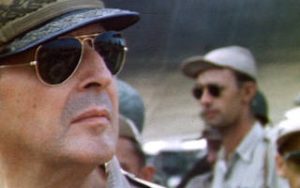Episode Four-The Enemy Underground
As Episode Four begins, it’s 1944 and the allies’ war effort is at full throttle. Better training, increased troop numbers and secure supply lines give the allies the upper hand over the Japanese. Historic color naval combat films are enhanced by the voices of the men that fought these battles.
Departing from the areas of combat the viewer examines 1944 Hawaii which has become a playground for combat troops on leave—a much different look than when last viewed on December 7, 1941 in the series opener.
A new weapon has been developed, the B-29, so new bases must be developed to accommodate this new bomber if Japan is to be attacked. Thus, attention shifts to the Mariana Islands, a larger and more distant target. Color film records the invasion buildup in Hawaii and preparations for the Navy’s assignment to deliver men and materials to the invasion site.
Amphibious assaults are still a work in progress and the voices of those that will participate give the viewer a sense of their unease. Unlike the bombardments the viewer saw in Episode Three, the Naval bombardment of Saipan will sacrifice accuracy for volume and this is seen in vivid color. Again, voices of the assault participants clearly describe the chaos on the landing beaches as the landings unfold.
Alerted that the Japanese fleet is steaming toward Saipan, the allied fleet must abandon the scene and find the Japanese fleet. The battle of the Philippine Sea results and is the biggest sea battle of the war. Spectacular color aerial photography shows the battle. With the fleets hundreds of miles apart it is pilot against pilot. The battle becomes known as the Marianas Turkey Shoot. Captured Japanese film accurately shows the chaos when its fleet is detected.
Ashore on Saipan the key prize is the airfield. Progress is slow because of confusion in the chain of command. The Marines are questioning the Army’s tactics and stomach for combat. Color home movies show the combat troops learning to adjust to tropical conditions. Here again voices of the participants supplement those of the series narrator. The movies show, and the voices describe, bathing, eating, sharing stories and the chance to reflect on what they have been through and what lies ahead.
The color films vividly tell the story of a new problem after victory is achieved. Residents of Saipan have been told by the Japanese that the Americans will kill them. As the Saipan residents are routed out of hiding their faces show this fear and uncertainty. Some of the survivors decide to commit suicide by jumping of the island’s cliffs. These scenes have been seen in previous documentaries but are still extremely difficult to view. Also difficult to view are scenes of the final Japanese banzai charge and its gory aftermath.
Episode Four concludes that island hopping is not getting easier. The next episode will demonstrate that the Japanese engine is cracking but is not yet shattered. If the B-29 is ready, and if the new airfields are ready, the Pacific war will be redefined. Stay tuned.



David Ebeling